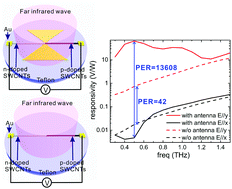Highly polarization-sensitive far infrared detector based on an optical antenna integrated aligned carbon nanotube film†
Abstract
Polarization detection is another important way to characterize a light field in addition to intensity and spectrum. This is required for high-fidelity information acquisition and high precision target recognition in the infrared detection region. Single-wall carbon nanotube (SWCNT) films have been investigated for infrared detection with considerable sensitivity at room temperature based on the photothermoelectric effect. In this work, a bowtie antenna integrated aligned SWCNT film is proposed for highly polarization sensitive, far infrared detection. The SWCNT film is shaped into a belt and doped with diverse agents to form a p–n junction at the center. The SWCNTs are arranged perpendicular to the electronic transportation direction. The antenna is aligned at the junction and along the SWCNTs. Based on the following four factors: (1) deep-subwavelength light concentration at the junction, (2) alignment between the SWCNTs and the antenna, (3) anisotropic heat transfer in the aligned SWCNT film, and (4) light field reduction within the gap of the bowtie antenna for the polarization perpendicular to the antenna axis, the ratio between the responsivities for the polarizations parallel and perpendicular to the SWCNTs could be higher than 13 600. By changing the size of the antenna, the resonant frequency could be tuned. Over the range from 0.5 to 1.5 THz, the peak polarization extinction ratios at different resonant frequencies are all bigger than 700, and they are 16 to 320 times higher than that of the aligned SWCNT belt without the antenna. Moreover, the integration of the antenna and the aligned SWCNT belt also enhances the responsivity by 1 to 2 orders of magnitude. Compared to an aligned multi-wall carbon nanotube (MWCNT) film, an aligned SWCNT film integrated with an optical antenna is more favorable for highly polarization sensitive, far infrared detection. The result is based on the numerical simulations of the light and the thermal fields.



 Please wait while we load your content...
Please wait while we load your content...